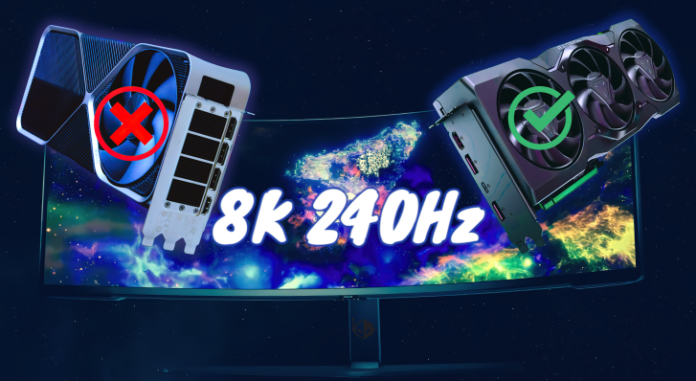
Samsung's Odyssey Neo G9 is categorized as a "benchmark" for the industry, with its "out of the world" specifications however, it is now reported that you can't run the monitor at its complete potential with any of NVIDIA's existing GPUs, even the flagship GeForce RTX 4090.
NVIDIA's GeForce RTX 4090 GPU Sees Display Limitations With Samsung's Odyssey Neo G9 Monitor
Before diving into the crux, let's give an overview of the Samsung Odyssey Neo G9. The gaming monitor boasts a 57-inch screen with "quantum mini LED technology" & a Dual QHD resolution reaching 7,680×2,160. The Odyssey Neo G9 features Vesa DisplayHDR 1000 certification and a 1000R curvature rate on a 32:9 panel to deliver the best ultrawide gaming experience. There are several other mentionable features, but our focus will now be on the actual display and more importantly, its refresh modes which include up to 8K 240Hz.
Samsung Odyssey Neo G9 can be said a product that is way ahead of its actual time, which is why even NVIDIA's flagship Ada GPU is no match for it. However, AMD's Radeon RX 7000 GPUs are now fully capable of supporting the 8K 240Hz mode, not only over DP 2.1 but also through HDMI 2.1.

The Samsung Odyssey Neo G9 is still in pre-order; however, numerous Korean users and reviewers have managed to obtain a unit, claiming that the NVIDIA GeForce RTX 4090 can only output an 8K display at 120Hz.
The factor that makes it sort of a "controversial" statement is that NVIDIA's GeForce RTX 4090 comes with an HDMI 2.1 port that, on paper, should output the desired display since it offers the same 48 Gbps bandwidth that allows AMD's Radeon RX 7000 GPUs to run it over HDMI 2.1, but that isn't the case here. It would be technically impossible to run the said mode over the DP 1.4 output since it lacks the required signal bandwidth but AMD also has an edge there since it offers DP 2.1 capabilities, allowing for up to 8K 480Hz modes.
As Reddit user Ratemytinder22 points out, the issue is most likely to do with the mechanism behind "Display Stream Compression" (DSC). It is a VESA-developed algorithm that targets efficient and high-resolution output.
To output the desired resolution, DSC makes use of "display pipelines" within the GPU silicon, and the reason why NVIDIA's GeForce RTX 4090 can't support the max display of Odyssey Neo G9 might be due to the "bottlenecks" created within the individual display pipelines to a single output port. Think of it as a four-lane highway merging into a single lane; this makes the disparity due to which 8K@240Hz might be unachievable for the RTX 40 GPUs.

Consumers thinking of getting the monitor might wonder what's the solution here. This depends on NVIDIA's approach with its silicon and whether the bandwidth sharing could support the 240Hz standard. If this is the case, then a driver/firmware update could get the job done, but if NVIDIA's silicon doesn't have adequate bandwidth sharing, well, you either have to wait for next-gen releases or opt for the AMD route.
During its gaming event at Gamescom, the red team heavily marketed the capabilities of its RDNA 3 GPU architecture and how it is the only chip design that is fully compatible with the Samsung Neo display and its insane 8K 240Hz mode. There is a slight chance Team Green could cater to this by allowing consumers to disable other ports (since the display pipelines are interconnected) on the GeForce RTX 4090 while aiming for an 8K@240Hz output. Still, this factor is also dependent on the silicon design.
I know this coverage is targeted towards the "highest-end" consumer in the industry, but we are making a point that even the "flagship" GPU has its own limitations. We can't say whether AMD has the edge over NVIDIA in this department since running something even at 8K requires lots of GPU horsepower and RTX 4090 excels over the 7900 XTX in every department but if you were to use it for some super-high refresh rate 8K gaming, then the 4090 might just be out of luck. Overall, it is safe to say that the Odyssey Neo G9 is a shocker by Samsung, and even using it at 8K@120Hz would be a delight to see.
WccftechContinue reading/original-link]




